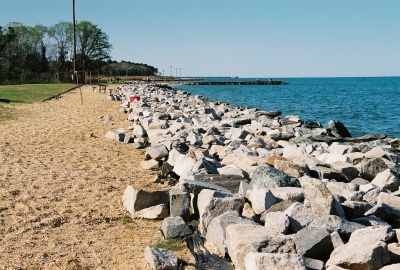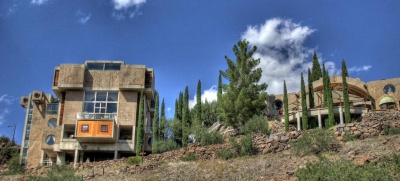 Earth Talk: From the Editors of E/The Environmental Magazine
Earth Talk: From the Editors of E/The Environmental Magazine
Dear EarthTalk: I've noticed a lot of beach erosion along the eastern U.S. coast. Beaches are virtually non-existent in places. Is this a usual cycle that will self-correct, or are these beaches permanently gone from sea level rise or other environmental causes? -- Jan Jesse, Morristown, TN

Rip Rap rocks line the shoreline at Point Lookout in St. Mary's County to prevent beach erosion. The U.S. Environmental Protection Agency estimates that 80 to 90 percent of the sandy beaches along America's coastlines have been eroding for decades. Individual beaches may lose only a few inches per year; others may lose much more. Of particular concern is the effect climate change, which causes sea level rises and also increases the severity and frequency of harsh storms, has on beach erosion. (Photo: David Noss)
Unfortunately for beach lovers and owners of high-priced beach-front homes, coastal erosion in any form is usually a one-way trip. Man-made techniques such as beach nourishment-whereby sand is dredged from off-shore sources and deposited along otherwise vanishing beaches-may slow the process, but nothing short of global cooling or some other major geomorphic change will stop it altogether.
According to Stephen Leatherman ("Dr. Beach") of the National Healthy Beaches Campaign, beach erosion is defined by the actual removal of sand from a beach to deeper water offshore or alongshore into inlets, tidal shoals and bays. Such erosion can result from any number of factors, including the simple inundation of the land by rising sea levels resulting from the melting of the polar ice caps.
Leatherman cites U.S. Environmental Protection Agency estimates that between 80 and 90 percent of the sandy beaches along America's coastlines have been eroding for decades. In many of these cases, individual beaches may be losing only a few inches per year, but in some cases the problem is much worse. The outer coast of Louisiana, which Leatherman refers to as "the erosion 'hot spot' of the U.S.," is losing some 50 feet of beach every year.
Of particular concern is the effect climate change, which not only causes sea levels to rise but also increases the severity and possibly the frequency of harsh storms, has on beach erosion. "While sea level rise sets the conditions for landward displacement of the shore, coastal storms supply the energy to do the 'geologic work' by moving the sand off and along the beach," writes Leatherman on his DrBeach.org website. "Therefore, beaches are greatly influenced by the frequency and magnitude of storms along a particular shoreline."
Besides collectively lowering our greenhouse gas emissions substantially, there is little that individuals-let alone coastal landowners-can do to stop beach erosion. Building a bulkhead or seawall along one or a few coastal properties may protect homes from damaging storm waves for a few years, but could end up doing more harm than good. "Bulkheads and seawalls may accelerate beach erosion by reflecting wave energy off the facing wall, impacting adjacent property owners as well," writes Leatherman, adding that such structures along retreating shorelines eventually cause diminished beach width and even loss.
Other larger scale techniques like beach nourishment may have better track records, at least in terms of slowing or delaying beach erosion, but are expensive enough as to warrant massive taxpayer expenditures. In the early 1980s, the city of Miami spent some $65 million adding sand to a 10-mile stretch of fast-eroding shoreline. Not only did the effort stave off erosion, it helped revitalize the tony South Beach neighborhood and rescue hotels, restaurants and shops there that cater to the rich and famous.
CONTACTS: Stephen Leatherman, www.drbeach.org ; National Healthy Beaches Campaign, www.ihrc.fiu.edu/nhbc .
Dear EarthTalk: What are "eco-villages?" I've heard of one in New York near Ithaca and another one called Arcosanti being built in Arizona. -- Jim Killian, Brookline, MA

Some 420 eco-villages exist in both urban and rural settings around the world today. Pictured here: the west end of Arcosanti, a self-described "experimental town" in Arizona that has been under construction since 1970. In keeping with the concept of clustered development so as to maximize open space and the efficient use of resources, the large, compact structures and large-scale solar greenhouses of Arcosanti occupy a small footprint—only 25 acres within the community's 4,000-acre "land preserve." (Photo: CodyR, courtesy Flickr)
Eco-villages are essentially designed communities intending to be socially, economically and ecologically sustainable. Environmentalist Joan Bokaer developed the vision for the first eco-village, which would eventually be built on the outskirts of Ithaca, New York, while on a continent-wide walk for sustainability across the United States in 1990. In Context magazine publisher Robert Gilman helped refine the concept through his research, writing and speaking on the topic. In 1996, the first residents moved into the EcoVillage at Ithaca, and a movement was born. According to the nonprofit Global Ecovillage Network, some 420 eco-villages exist in both urban and rural settings around the world today.
The defining characteristics of an eco-village, according to Robert Gilman's seminal 1991 article, "The Eco-Village Challenge," include "human-scale, healthy and sustainable development, full-featured settlement, and the harmless integration of human activities into the natural world." Gilman also said that eco-villages should limit their populations to 150 individuals, which is the maximum size for any working social network according to the teachings of sociology and anthropology.
While the term eco-village did not come into common usage until the 1990s, the concept may in fact be older. Arcosanti, a self-described "experimental town" in the high desert of Arizona, 70 miles north of Phoenix, has been under construction since 1970 and eventually will be the home of some 5,000 forward-thinking residents. In keeping with the concept of clustered development so as to maximize open space and the efficient use of resources, the large, compact structures and large-scale solar greenhouses of Arcosanti occupy a small footprint-only 25 acres-within the community's 4,000-acre "land preserve."
Italian architect Paolo Soleri designed Arcosanti according to his concept of "arcology" (architecture + ecology), whereby, in his words, "the built and the living interact as organs would in a highly evolved being." Underpinning the concept is that "many systems work together, with efficient circulation of people and resources, multi-use buildings, and solar orientation for lighting, heating and cooling."
Those interested in learning more can attend a four-week workshop at Arcosanti to study building techniques and arcological philosophy, while getting a chance to contribute to the city's ongoing construction. To date, some 5,000 participants have all had a hand in the construction of Arcosanti.
Some other "intentional communities" designed with sustainability in mind around North America include Cobb Hill in Vermont, Vegan in Hawaii, Dancing Rabbit in Missouri, Maitreya in Oregon, Dreamtime in Wisconsin, Paz in Texas, Earthaven in North Carolina, Prairie's Edge in Manitoba and Kakwa in British Columbia. For information on these and other eco-villages, the Ecovillage Network of the Americas as well as the Global Ecovillage Network offer extensive resources for free online.
CONTACTS: EcoVillage at Ithaca, www.ecovillage.ithaca.ny.us ; Robert Gilman's "The Eco-Village Challenge," www.context.org/ICLIB/IC29/Gilman1.htm ; Arcosanti, www.arcosanti.org ; Ecovillage Network of the Americas, ena.ecovillage.org ; Global Ecovillage Network, gen.ecovillage.org.
GOT AN ENVIRONMENTAL QUESTION? Send it to: EarthTalk, c/o E/The Environmental Magazine, P.O. Box 5098, Westport, CT 06881 or e-mail: earthtalk (at) emagazine.com.


